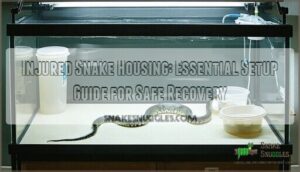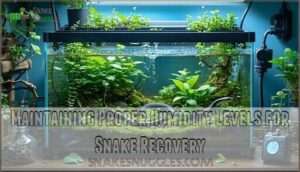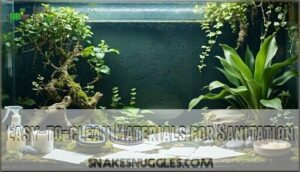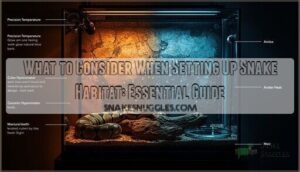This site is supported by our readers. We may earn a commission, at no cost to you, if you purchase through links.

You’ll need a secure, escape-proof enclosure that’s easy to clean and disinfect.
Size it right for your species – too big creates stress, too small restricts movement.
Think hospital room, not luxury suite.
Choose smooth materials that won’t snag wounds, and make certain proper ventilation without drafts.
Skip fancy decorations for now; focus on essentials like appropriate hide boxes and accessible water dishes.
Temperature and humidity control matter more than ever since injured snakes can’t regulate themselves well.
The right setup turns recovery from a nightmare into a manageable process with the right temperature control.
Table Of Contents
- Key Takeaways
- Selecting The Right Enclosure for Injured Snakes
- Creating an Optimal Temperature Gradient
- Maintaining Proper Humidity Levels for Snake Recovery
- Choosing Appropriate Substrate for Injured Snakes
- Essential Furnishings for Injured Snake Comfort
- Frequently Asked Questions (FAQs)
- How do human activities affect the survival of injured snakes?
- Can snakes survive a snake injury?
- What happens if a snake is injured?
- How do you care for a snake after rehabilitation?
- What if a snake is injured in a garden?
- How do nursing staff care for injured snakes?
- What to do if you find an injured snake?
- How to help an injured garden snake?
- How to treat an open wound on a snake naturally?
- How often should I clean the injured snakes enclosure?
- Conclusion
Key Takeaways
- Choose the right enclosure size – You’ll need a space that matches your snake’s species and adult size, not just its current length, while avoiding overly large spaces that create stress during recovery.
- Prioritize easy cleaning and security – You’ll want non-porous materials like PVC or glass that resist bacteria, plus escape-proof designs with lockable lids and smooth surfaces.
- Master temperature and humidity control – You’ll need to create a proper thermal gradient (basking spot to cool zone) and maintain species-specific humidity levels using digital monitoring tools.
- Keep furnishings simple and safe – You’ll want to skip fancy decorations and focus on essentials like appropriate hide boxes, shallow water dishes, and dust-free substrates that won’t irritate wounds.
Selecting The Right Enclosure for Injured Snakes
When your snake is injured, choosing the right enclosure becomes critical for their recovery and safety.
You’ll need to balance medical access with security, comfort, and cleanliness to give your scaly patient the best chance at healing.
Size Considerations Based on Snake Species
When setting up your injured snake’s enclosure, think big picture first.
You’ll need space that matches your snake’s adult size and growth rate, not just its current length.
A corn snake reaching 5 feet needs different space than a ball python maxing out at 4 feet.
Consider species needs too – some snakes stretch out fully while others coil up.
Your enclosure volume should allow natural movement without cramping recovery.
Remember that enclosure size impacts health is a crucial factor in ensuring your snake’s well-being and healthy recovery.
Secure and Escape-proof Designs
Beyond proper sizing, your snake’s enclosure must be Fort Knox-level secure.
Injured snakes still possess remarkable escape skills, so you’ll need these safety features:
- Lockable lids that clamp down tight—no wiggle room allowed
- Smooth surfaces inside to prevent climbing adventures
- Small holes for ventilation that won’t become exit routes
- Double doors for extra security during cleaning and care
Check for damage regularly since snakes find weak spots like detectives.
It’s important to use reliable enclosure locks to prevent escapes.
Your escapeproof design keeps everyone safe.
Materials for Easy Cleaning and Disinfection
Your choice of snake enclosure materials directly impacts how easily you can maintain a sterile environment for your injured snake.
Non-porous materials like HDPE and PVC resist bacterial growth and handle safe disinfectants without breaking down. These durable options cost more upfront but last decades with proper snake enclosure cleaning.
Glass works well too, though it’s heavier and pricier than plastic alternatives for effective snake enclosure sanitation.
For observation windows, consider polycarbonate as a durable and transparent alternative to glass, which can be a key factor in maintaining a clean and healthy environment.
Ventilation Requirements for Proper Air Circulation
Your snake’s enclosure needs proper airflow to prevent respiratory issues and maintain healthy conditions.
Good ventilation keeps air fresh without creating drafts that stress injured snakes. Think of it like opening a window just enough to let air move naturally through your home.
- Position vents strategically – Place mesh panels on opposite sides to create cross-ventilation
- Size matters – Use small holes that prevent escapes while allowing adequate airflow
- Avoid direct drafts – Position vents away from basking areas to prevent temperature drops
- Monitor humidity levels – Proper ventilation helps control moisture without overdrying the environment
Accessibility Features for Medical Treatment
When medical care becomes necessary, you’ll want easy medication access through your snake enclosure design.
Install removable top panels or side doors for wound observation without disturbing your patient.
Position supplies within arm’s reach to minimize limited movement during treatment.
Smart snake enclosure accessibility reduces handling time, promoting stress reduction while ensuring thorough cleaning access for ideal recovery conditions.
Creating an Optimal Temperature Gradient
You’ll create a healing sanctuary when you master the thermal gradient—your injured snake’s pathway to recovery. Think of it as building a mini climate zone where your snake can choose its perfect temperature spot.
Here’s your temperature setup checklist:
- Position your heat lamp strategically at one end to create a proper basking spot for thermal regulation
- Install a heat mat covering 1/3 of the floor to provide essential belly heat for digestion and healing
- Use multiple thermometers for temperature monitoring to track your thermal gradient across the entire snake enclosure
- Maintain species-specific temperatures by adjusting heat sources to keep the warm end at ideal recovery levels
Your snake enclosure temperature gradient should range from the basking spot (around 85-95°F for most species) down to a cooler area (75-80°F). This snake enclosure temperature setup lets your patient self-regulate, moving between zones as needed. Remember, consistent snake temperature control speeds healing and prevents complications. A proper temperature gradient is essential for thermoregulation.
Maintaining Proper Humidity Levels for Snake Recovery
Getting the humidity right for your injured snake isn’t just about comfort—it’s essential for proper healing and preventing infections.
You’ll need to match your snake’s natural humidity needs while keeping wounds clean and dry.
Species-specific Humidity Requirements
With your temperature gradient set, matching snake species to their natural species origin becomes key for snake enclosure humidity success.
Tropical species like ball pythons need 60-80% humidity to prevent shedding problems, while desert kings prefer 30-50% to avoid respiratory issues.
Wrong humidity levels can seriously humidity impact recovery, so research your specific snake enclosure proper humidity needs before setting up enclosure misting systems.
Humidity Control Methods and Equipment
Getting your snake’s humidity just right doesn’t have to be rocket science.
Here’s what you’ll need:
- Humidifiers Types – ultrasonic models work great for snake enclosure humidity control
- Misting Systems – automated sprayers keep snake humidity levels steady
- Substrate Moisture management – damp paper towels boost humidity naturally
A hydrometer tracks your progress, while good ventilation prevents mold.
Water bowls also help maintain proper humidity!
Selecting the right substrate, like coconut fiber, is essential for moisture retention.
Monitoring Tools for Accurate Readings
You’ll need reliable tools to track your snake’s environment accurately.
Digital hygrometers beat analog ones for precision, while thermometers with remote probes let you monitor multiple zones.
Consider data loggers that record readings over time – they’re like having a constant health check.
Place sensors at different heights for complete coverage.
Regular thermometer calibration and hygrometer accuracy checks keep your monitoring sharp and your snake safe.
Accurate humidity readings rely on using digital hygrometers for ideal results.
Balancing Humidity With Injury Care Needs
Finding the sweet spot between Humidity Control and Injury Healing requires careful attention.
Your Recovery Environment needs balanced moisture levels that support Snake Hydration without compromising Wound Management.
Monitor humidity daily and adjust based on your snake’s healing progress.
Too much moisture can slow recovery, while too little can cause stress.
Key considerations for snake wound care:
- Broken hearts heal faster – your injured snake needs hope through proper humidity
- Every small adjustment matters – minor changes can mean survival or suffering
- Trust builds through consistency – stable conditions show your snake it’s safe
- Healing takes patience – rushing humidity changes can undo progress
- Your dedication saves lives – proper reptile recovery habitat management makes all the difference
Choosing Appropriate Substrate for Injured Snakes
The right substrate can make or break your injured snake’s recovery, so you’ll want to choose materials that won’t irritate wounds or harbor harmful bacteria.
Your substrate selection should prioritize cleanliness and comfort while supporting the healing process.
Hypoallergenic and Dust-free Options
Your snake’s recovery depends on clean, irritation-free substrate options.
Paper towels offer the best allergy prevention and dust free materials for snake safety.
Aspen bedding and coconut coir provide hypoallergenic choices that won’t trigger respiratory problems.
Skip cypress mulch—it’s toxic.
These snake enclosure substrate options create a healing environment where your injured friend can focus on getting better, not fighting allergens.
Moisture-retaining Substrates for Humid Environments
Beyond basic hypoallergenic options, you’ll want substrates that hold moisture for species needing humid environments.
Sphagnum moss works like a natural sponge, keeping humidity steady without getting soggy. Coconut fiber breaks down slowly and holds water well. Peat substrate retains moisture but can be acidic – test your snake’s tolerance first. Think of these as your humidity insurance policy.
Here’s what makes moisture-retaining substrates work:
- Sphagnum moss absorbs up to 20 times its weight in water
- Coconut fiber prevents mold growth while staying damp
- Peat substrate creates acidic conditions that discourage bacteria
- Humidity control becomes easier with consistent moisture release
- Snake enclosure substrate options should match your species’ natural habitat needs
Easy-to-clean Materials for Sanitation
While humidity matters for healing, you’ll also want substrates that clean up easily.
Paper towels top the list—they’re cheap, disposable, and show blood or discharge right away.
Reptile carpet works too, but wash it weekly.
PVC panels and melamine materials make great enclosure liners since they wipe clean with reptile-safe disinfectants.
Skip anything that holds onto germs.
Avoiding Substrates That May Irritate Wounds
Wound Irritation is no joke—your snake’s healing depends on smart Substrate Safety.
Skip rough stuff like sand or wood chips. They can cause Injury Prevention headaches, from snake wound infections to intestinal impaction or even cedar toxicity.
For Snake Comfort and Wound Healing, stick to these five safe picks:
- Paper towels
- Unprinted newspaper
- Reptile carpet
- Indoor/outdoor carpet
- Clean towels
Proper substrate selection involves considering substrate health benefits to guarantee the best environment for recovery.
Essential Furnishings for Injured Snake Comfort
Beyond the basics of housing, your injured snake needs the right furniture to feel secure and heal properly.
Think of it as setting up a recovery room that’s both safe and comfortable for your scaly patient.
Suitable Hide Boxes for Security
Your snake needs a secure retreat for healing and stress relief.
A safe hideaway speeds healing – your snake’s sanctuary matters most.
Choose hide boxes made from plastic or resin with secure lids that won’t pop open during recovery.
Position them away from high-traffic areas and verify proper box ventilation through small holes.
Locking mechanisms prevent escapes while you’re cleaning.
Size matters—pick a snake hide box that’s snug but not cramped, about 1.5 times your snake’s body length.
This creates the perfect sanctuary for recovery.
Branches and Perches for Arboreal Species
Arboreal species need Climbing Structures that mimic their natural habitat.
Choose sturdy Tree Limbs like driftwood or secure branches that won’t snap under weight. Branch Selection matters – pick smooth surfaces that won’t snag healing wounds.
Perch Materials should be easy to clean and disinfect. Position snake branches at different heights for snake environmental enrichment.
Arboreal Support helps injured climbers feel secure while recovering.
Water Dishes Adapted for Injured Snakes
With your arboreal snake’s perches in place, let’s focus on their water needs. Injured snakes require careful hydration without drowning risks.
Shallow Bowls work best for weak or recovering snakes. Keep water depth under two inches to prevent accidents. Stable Dishes with weighted bases won’t tip when your snake moves around. Look for anti-bacterial materials like ceramic or resin.
Here’s what makes snake enclosure water dishes work well:
- Ramp Access – textured entry points help snakes with limited mobility
- Wide, flat bottoms that resist tipping over
- Smooth surfaces that clean easily and resist bacteria
- Proper sizing for soaking without drowning risk
Using shallow water bowls is essential for safe hydration. Your reptile water bowl should let them drink and soak safely while recovering.
Environmental Enrichment Items for Mental Stimulation
Mental enrichment helps injured snakes heal faster and stay calm.
A calm mind speeds healing – even for snakes recovering from injury.
Puzzle toys and foraging games keep their minds busy during recovery. Add climbing structures for arboreal species, but keep them low and safe.
Sensory stimulation through different textures reduces stress. Simple mental exercises like hiding food encourage natural behaviors without overexertion.
Providing the right snake habitat essentials is essential for their overall well-being and recovery.
Frequently Asked Questions (FAQs)
How do human activities affect the survival of injured snakes?
Human activities cause many snake injuries through habitat destruction, vehicle strikes, and pollution.
You can help by driving carefully, protecting natural areas, and contacting wildlife rehabilitators when you find injured snakes.
Can snakes survive a snake injury?
Yes, snakes can survive injuries depending on their severity and type. Minor wounds heal through natural shedding and regeneration, while severe trauma requires immediate veterinary care for survival.
What happens if a snake is injured?
When you find an injured snake, it’ll likely experience immediate effects like blood loss, shock, and pain.
The snake may seek shelter, reduce activity, and alter hunting behaviors to survive while its natural healing abilities kick in, which can help mitigate the effects of shock.
How do you care for a snake after rehabilitation?
After rehabilitation, you’ll gradually reintroduce your snake to normal activities.
Start with short feeding sessions, then increase exercise time.
Monitor closely for any health changes or stress signs before considering release to the wild.
What if a snake is injured in a garden?
When a snake becomes your garden’s unexpected guest, don’t panic!
Contact a licensed wildlife rehabilitator immediately—they’re legally required to handle injured wildlife.
Never attempt care yourself, as it’s illegal and dangerous.
How do nursing staff care for injured snakes?
Caring for injured snakes requires specialized training and permits.
You’ll monitor temperatures, maintain clean enclosures, provide appropriate substrates, and guarantee proper humidity.
Only licensed wildlife rehabilitators can legally handle injured snakes.
What to do if you find an injured snake?
Stay calm and don’t approach the snake directly.
Contact a licensed wildlife rehabilitator immediately – they’re the only ones legally authorized to handle injured wildlife.
Keep pets and people away from the area until help arrives, and remember to stay calm and let the licensed wildlife rehabilitator handle the situation.
How to help an injured garden snake?
Picture finding a garden snake limping like it lost a bet with a lawnmower.
Gently scoop it into a ventilated box, don’t offer food, and call a wildlife rehabber.
Don’t play doctor—snakes need pros!
How to treat an open wound on a snake naturally?
Don’t treat snake wounds naturally at home.
You’re not equipped for this, and it’s actually illegal without proper permits.
Contact a licensed wildlife rehabilitator immediately – they’ll handle wound care safely and legally.
How often should I clean the injured snakes enclosure?
Clean your injured snake’s enclosure every 2-3 days, or immediately after soiling.
Remove uneaten food and waste promptly to prevent bacteria buildup.
Use disinfectant-safe materials and monitor wounds during cleaning sessions to ensure a clean and safe environment for your snake, focusing on disinfectant-safe handling.
Conclusion
Successfully setting up injured snake housing creates the foundation for your pet’s recovery.
You’ve learned the basics – proper enclosure size, temperature control, and safe materials.
Your snake’s healing depends on these details working together.
Remember to keep things simple and clean.
Skip fancy decorations until your snake feels better.
With the right injured snake housing setup, you’re giving your pet the best chance to heal quickly and return to normal life.
- https://petadvocacy.org/wp-content/uploads/2022/01/Snakes-Care-Sheet.pdf
- http://www.rehabbersden.org/index.php/rehab/housing
- https://vcahospitals.com/know-your-pet/snakes---housing
- https://nt.gov.au/environment/animals/caring-for-wildlife/caring-for-snakes
- https://www.merckvetmanual.com/multimedia/table/reptile-housing-requirements












